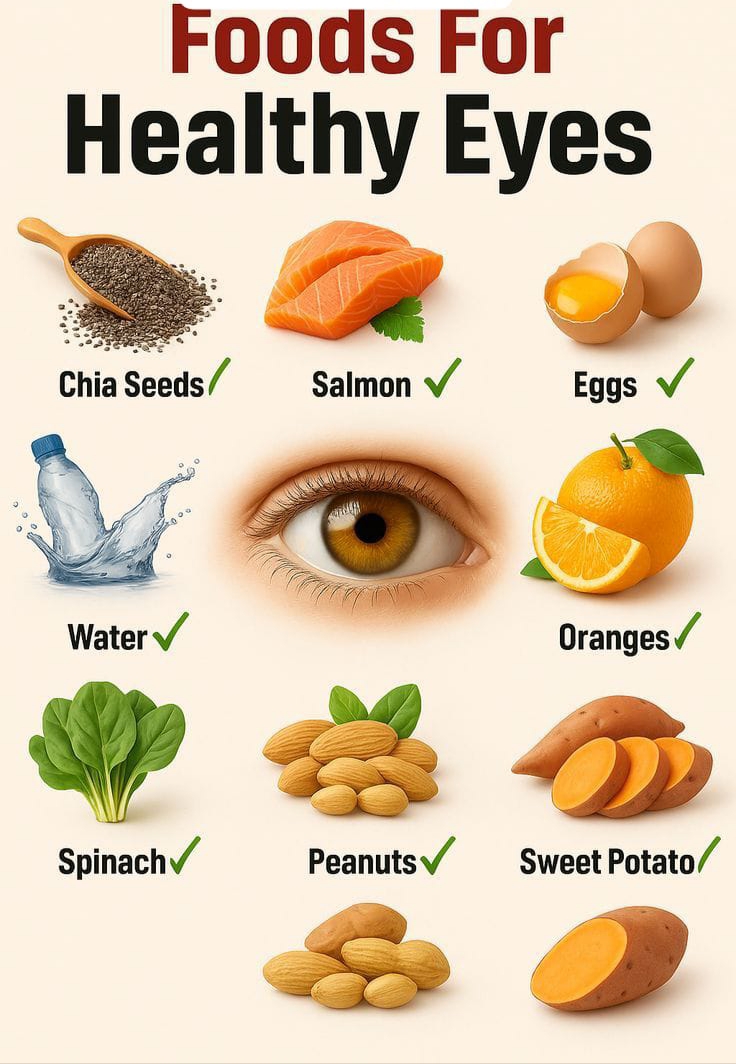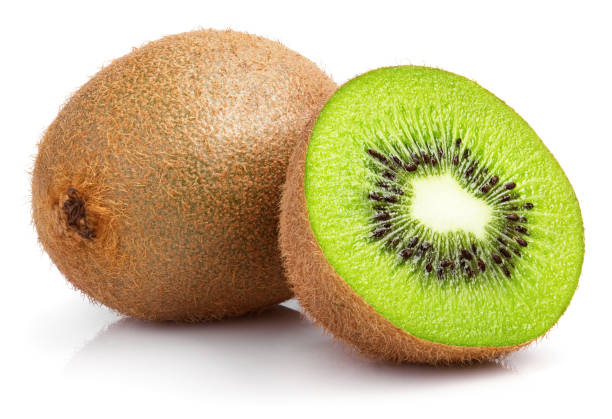
Our eyes do a lot of work every day. They focus, track, and translate a constant stream of light into the scenes we live inside. What you eat affects how well that work gets done. The image above points to familiar kitchen staples that carry real benefits for vision. This article explains why those foods matter, how to use them in simple meals, and what practical habits help your eyes stay sharp as you age.
Foods like spinach and sweet potato are not just colorful. They are rich in nutrients called lutein and zeaxanthin. These carotenoids accumulate in the retina and act like a natural sunshade, filtering harmful blue light and reducing oxidative stress. Eating these vegetables regularly increases the concentration of those pigments in the eye, which studies link to lower risk of age related changes in vision. A handful of cooked spinach or a small baked sweet potato a few times a week moves you toward protective levels.
Salmon stands out for omega three fats, especially DHA. The retina needs fats to maintain structure and function. Omega three fats support the tear film and help the eye surface stay comfortable and clear. If your eyes feel dry after long hours at a screen, adding a portion of oily fish twice a week can improve comfort over time. For people who do not eat fish, a discussion with a clinician about safe supplements makes sense but food first is the simplest path.
Eggs bring together several advantages in one small package. The yolk concentrates lutein and zeaxanthin and also contains vitamin A precursors that support the cells that detect light. A cooked egg at breakfast is an easy, low cost way to top up multiple eye nutrients at once. When possible choose eggs from hens that were fed diets high in carotenoids. The labels do not always say this, but free range poultry and eggs from local suppliers often reflect a more varied diet, which can translate into slightly higher nutrient content.
Oranges and other citrus are strong sources of vitamin C. Vitamin C is an antioxidant that supports blood vessels and connective tissue throughout the body, including the small vessels in the eye. Regular intake from whole fruit helps maintain overall tissue resilience. Eating an orange as a snack or adding citrus segments to a salad also adds flavor and encourages more varied plant intake, which is always good for long term eye health.
Nuts and seeds like almonds and chia provide vitamin E and plant based omega three fats. Vitamin E helps protect cell membranes against oxidative damage. A small handful of nuts most days fits easily into a budget and a routine. Peanuts, though technically a legume, supply protein and healthy fats that support overall nutrition. Keep portions moderate because nuts are calorie dense. A small portion goes a long way toward providing steady nutrient support.
Hydration is surprisingly important. Tears are the eye surface's first defense. Drinking water regularly, and limiting excessive alcohol which dehydrates, helps maintain a healthy tear film. For people who work long hours at screens, regular short breaks, blinking exercises, and a bottle of water on the desk are practical steps that reduce dry eye symptoms and protect the front surface of the eye.
Putting these foods into real meals is where the theory becomes practice. For breakfast try a spinach and egg omelette with a side of sliced orange. The greens deliver lutein and zeaxanthin, the egg supplies vitamin A precursors and fat, and the orange supplies vitamin C. For lunch build a salad with mixed greens, roasted sweet potato cubes, a handful of roasted almonds, and a piece of salmon or a salmon salad. Dress with olive oil which helps absorb fat soluble nutrients. For a snack mix chia pudding with mashed banana and a splash of milk or a yogurt that you like. Chia provides plant based omega three fats and fiber that helps steady appetite.
If you prefer simple cooking, a sheet pan dinner is efficient. Roast salmon fillets, sweet potato rounds, and a tray of seasoned spinach leaves that wilt in the last five minutes. Plate with a wedge of orange or a citrus vinaigrette. These meals stay flavorful while covering a range of nutrients visually shown in the image.
Shopping and storage tips matter as much as meal ideas. For leafy greens buy fresh and use within a few days if possible. If fresh greens are not available, frozen spinach and kale retain much of their nutrient content and are often more affordable. Store nuts in the fridge if your climate is warm to prevent rancidity. Choose whole food sources over processed products that claim to be fortified. Whole foods come with natural vitamin and mineral packages that work together in ways supplements cannot fully mimic.
There are a few cautions worth mentioning. Supplements can help in some cases, but they are not a free pass. Large, indiscriminate doses of isolated nutrients can interact with medications or be unnecessary when dietary intake is adequate. People with eye conditions, such as retinal disease or macular changes, should follow clinical advice about supplements designed for those conditions. Always check with a healthcare professional before starting a new supplement, especially if you are taking other medications.
Lifestyle choices combine with diet to amplify benefits. Protecting eyes from bright sunlight with sunglasses that block ultraviolet rays reduces cumulative light damage. Managing blood sugar through balanced meals and stable carbohydrates lowers risk for diabetic eye disease. Sleep matters too. Repair and regeneration happen during restful sleep and poor sleep patterns can worsen dry eye symptoms and visual focus. Finally take regular screen breaks using a ratio that works for you, for example twenty minutes of screen time followed by a twenty second look at something twenty feet away. Small micro habits like this reduce eye strain and help maintain sharp focus over long workdays.
The image highlights a useful point. You do not need exotic foods or expensive blends to support eye health. Everyday items from the market, combined thoughtfully across the week, build a protective diet. Focus on variety, pick a few nutrient dense foods you enjoy, and include them consistently. Little changes add up.
If you want to test the approach, try a two week plan. Add one egg at breakfast four times a week. Include a vegetable rich salad or a cooked leafy green with lunch every other day. Swap a snack for a small handful of nuts and a piece of fruit. Aim for two servings of fatty fish per week or plant based substitutes with similar fat profiles. At the end of two weeks note whether dry eye symptoms are less frequent and whether you feel more steady energy through the day. Small wins will motivate you to keep going.
Eating for eye health is not about instant fixes. It is about steady choices that support how the eye works, from the tear film to the retina. The foods in the image are practical building blocks. Use them in ways that fit your routine and taste. Over time the habits you form in the kitchen are the same ones that help your eyes keep doing their most important job.









Comments (0)